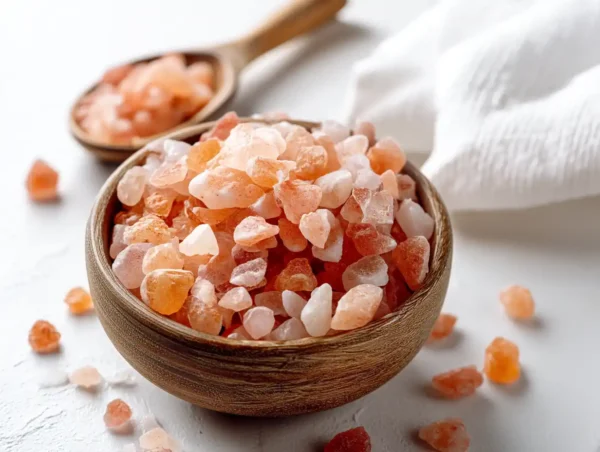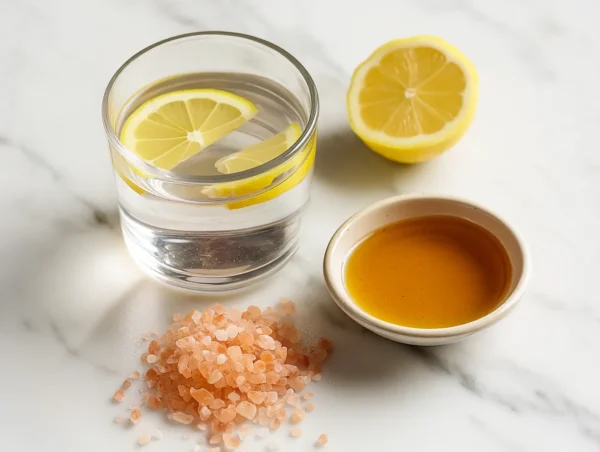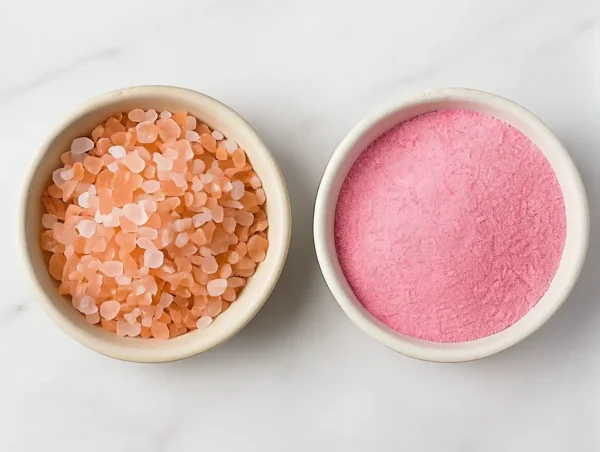I often see Himalayan pink salt on kitchen shelves and restaurant tables, and I’ve used it myself, drawn by its soft blush color. It feels special at first glance, almost like it must have something unique to offer. But I’ve always wondered, beyond its looks, how different is it really from the table salt we use every day?
In this article, I want to walk you through its real story: where it comes from, what it’s made of, the benefits people often mention, and the hidden risks that rarely get attention. Think of it as a way to clear up the myths and simply understand this popular ingredient for what it truly is.
If you’re curious about how pink salt sometimes shows up in wellness drinks, or want reliable background on sodium and health from the Harvard T.H. Chan School of Public Health, you’ll find both perspectives helpful as we dive in.
Here’s a simple view of pink salt itself, captured in the way many of us first encounter it at home:
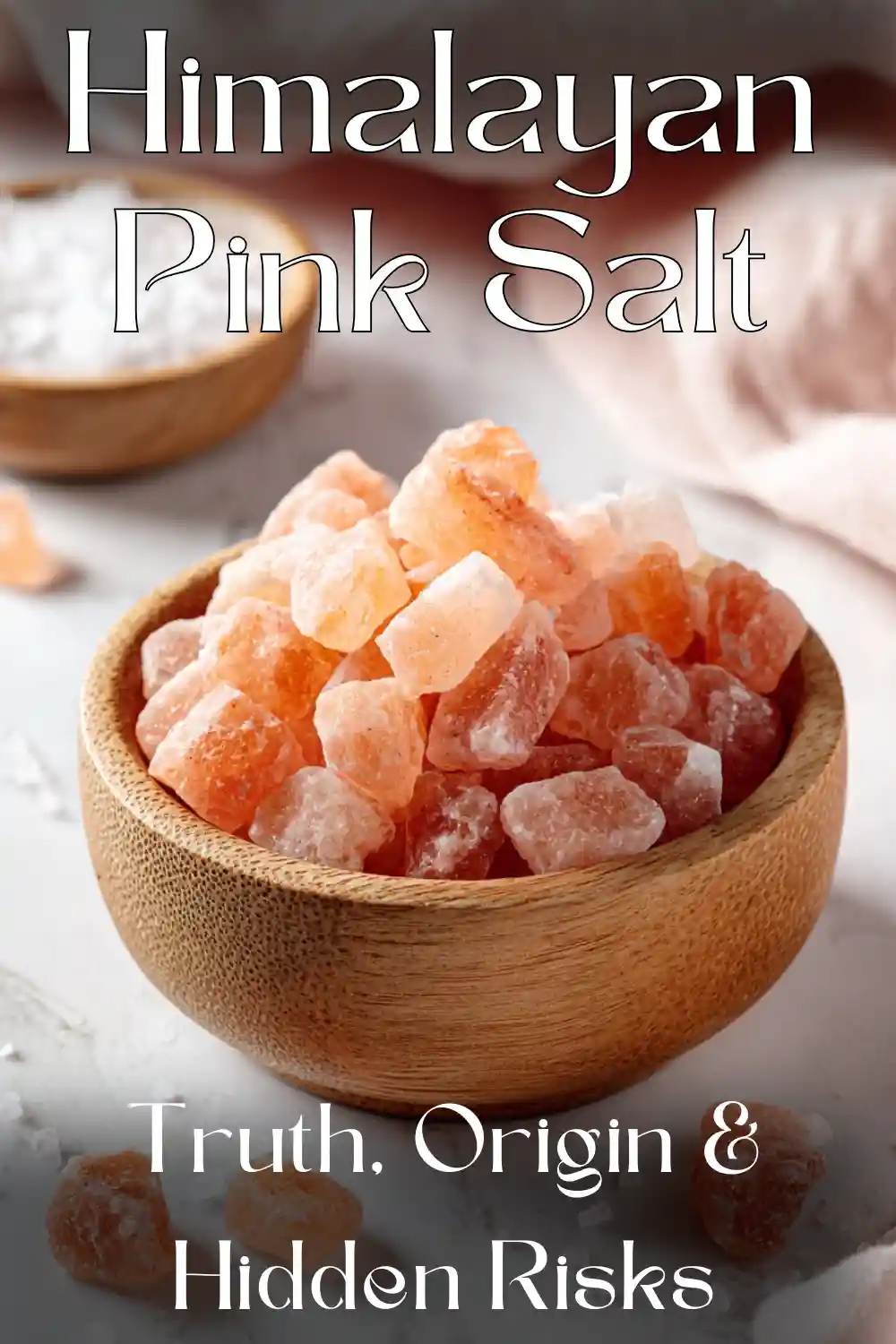
Table of Contents
Where Does “Himalayan Salt” Really Come From?
Himalayan pink salt does not come from snowy mountain peaks. Its true source is the Khewra Salt Mine in Pakistan, one of the world’s largest and oldest salt mines. These crystals were formed millions of years ago from the remains of an ancient ocean, leaving behind a fossilized trace of deep geological history.
The name “Himalayan” was later introduced as a marketing strategy, meant to evoke purity and exotic origins, even though the mine lies well outside the Himalayan range. Knowing this background helps us see pink salt less as a mystical product and more as a natural resource with a long, documented story. If you’d like to see how these same crystals shine in the kitchen, explore our guide on the Himalayan salt block.
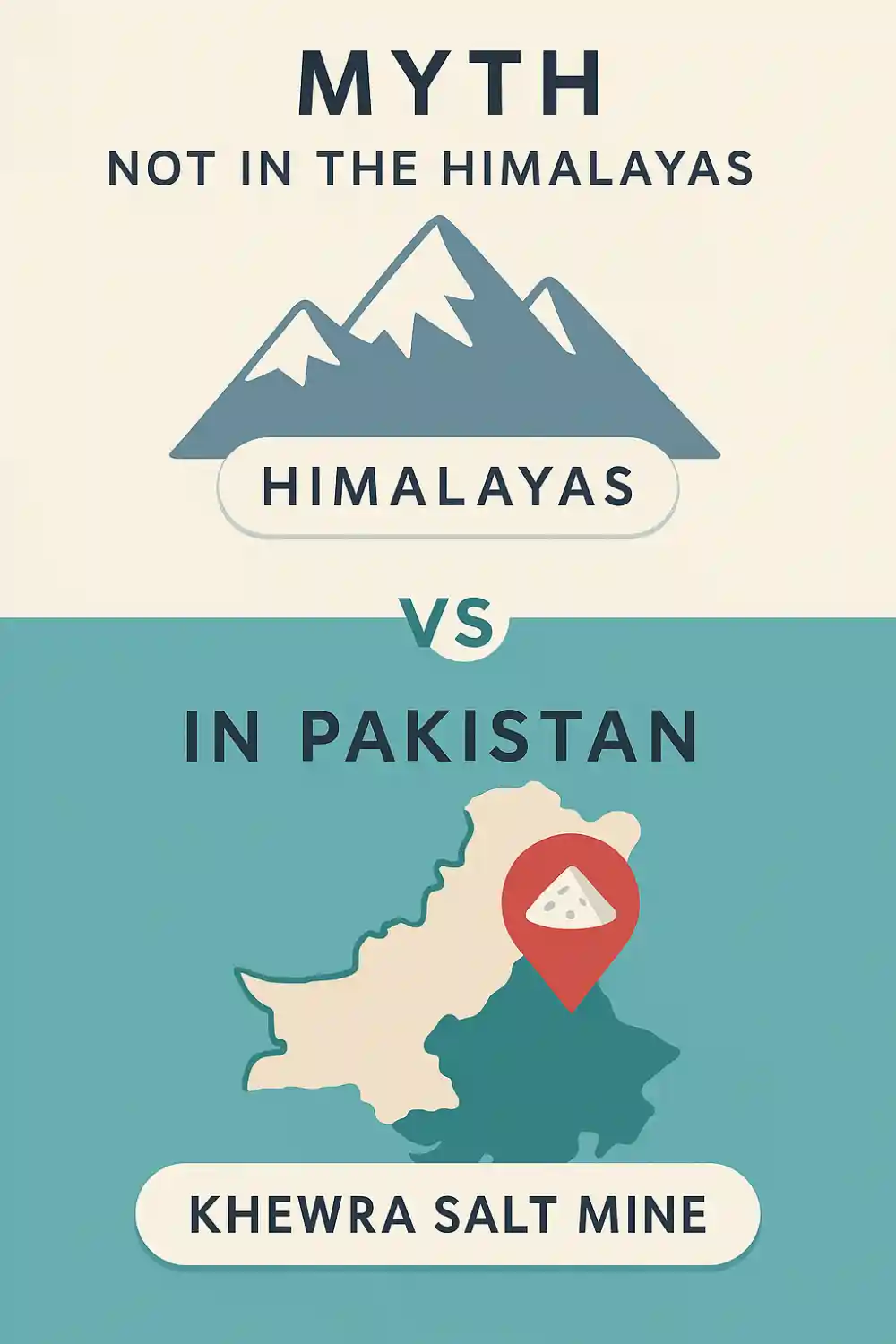
For further background, see the Khewra Salt Mine overview and UNESCO’s note on the Salt Range.
The Great Myth of 84 Minerals: A Scientific Analysis
Himalayan pink salt is often promoted as containing “84 minerals,” which makes it sound almost magical. In reality, it is composed of about 96–98% sodium chloride, making it nearly identical to regular table salt. The remaining 2% includes trace minerals like iron, potassium, magnesium, and calcium, but the amounts are so small that they don’t provide measurable pink salt benefits.
To put this into perspective, everyday foods provide far more nutrients: a single banana or a handful of almonds contains more potassium or magnesium than an entire teaspoon of pink salt. From a nutritional standpoint, the real distinction between pink salt vs table salt lies in the addition of iodine to table salt, not in trace minerals.
| Salt Type | Sodium Chloride (%) | Minerals | Nutritional Value |
|---|---|---|---|
| Pink Salt | 96–98 | Traces (Fe, Mg, K) | Negligible |
| Table Salt (iodized) | 97–99 | Iodine added | Essential |
| Sea Salt | 96–98 | Variable traces | Minimal |
Scientific analyses, such as Fayet-Moore et al. (2020), confirm that while pink salt does contain trace minerals, the levels are far too low to make a real nutritional difference.
The Hidden Dangers: What the Labels Don’t Say
Himalayan pink salt often looks so natural and pure that it feels safer than regular table salt. In reality, behind its pretty crystals, there are hidden risks that rarely make it onto the labels. Knowing them doesn’t mean avoiding pink salt altogether, it simply helps us use it with perspective and balance.
Risk of Heavy Metal Contamination
Tests on Himalayan pink salt have revealed small amounts of heavy metals, including lead and sometimes arsenic. While levels are usually low, the idea of heavy metals in a seasoning we use daily is worth keeping in mind. Long-term exposure, even at trace levels, can accumulate in the body. An investigation by Foodwatch Australia found that some pink salts contained heavy metals above safe levels, showing how inconsistent quality among products can pose a risk.
The Surprising Presence of Microplastics
Like sea salt, Himalayan pink salt is not immune to global pollution. Research on commercial salts found measurable levels of microplastics, confirming that the issue is not unique to sea salt but reflects widespread contamination. When we ask if pink salt is safe, the honest answer is that it’s no safer than other salts when it comes to microplastic exposure.
The Absence of Iodine: A Forgotten Deficiency Risk
Unlike iodized table salt, Himalayan pink salt does not contain added iodine. For many people, this isn’t a problem if their diet already provides iodine through dairy, seafood, or fortified foods. But in populations where deficiency is common, relying only on pink salt can raise the risk of iodine deficiency. The National Institutes of Health explains that iodine is essential for thyroid health, and using iodized salt remains one of the simplest ways to prevent deficiency.
For a closer look at salt safety, see our note on why pink salt should never be confused with pink curing salt.
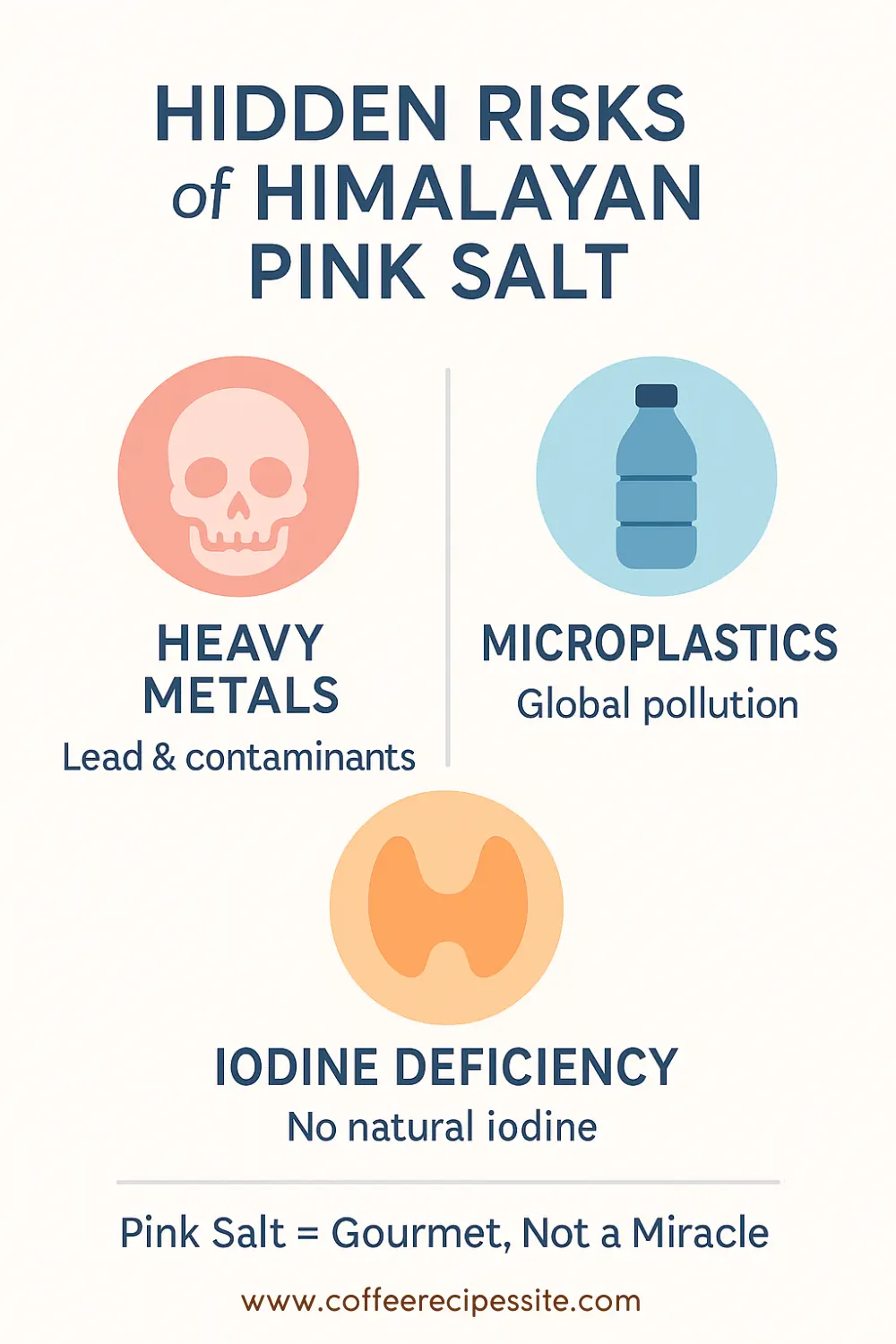
The Pink Salt Trick for Weight Loss: Fact or Fiction?
What Is the Pink Salt Trick?
On TikTok and Instagram, you’ve probably seen the pink salt trick: a drink made with water, lemon juice, and Himalayan pink salt. Its fresh look and the way it’s labeled as a “detox” makes it sound like a secret weight-loss remedy. The idea spread quickly because it feels simple and natural, but does the reality match the hype?
What People Say About It
Many pink salt trick reviews talk about feeling lighter, less bloated, or more energized after trying the drink. These experiences are real for those who share them, but they are based on personal impressions rather than scientific evidence. Most of these effects likely come from hydration and drinking more water, not from the salt itself.
What Science Really Shows
From a nutritional perspective, there is no proof that pink salt has any direct role in fat loss. When people ask, does pink Himalayan salt help with weight loss, the honest answer is no. The benefits come from water increasing satiety and lemon adding flavor that encourages hydration. That’s why the so-called pink salt weight loss myth is more about lifestyle choices than salt itself. For healthier ways to enjoy pink salt, see our guide on pink salt drinks.
For more background, see Healthline’s comparison of pink Himalayan salt vs. regular salt, which explains that current evidence doesn’t show meaningful advantages for weight loss or overall health.
Comparison Chart – Pink Salt vs. Table Salt vs. Sea Salt
To put everything into perspective, here is a side-by-side comparison of Himalayan pink salt, iodized table salt, and sea salt. The chart highlights key factors, origin, composition, iodine, risks, and price, so you can see at a glance how similar they really are.
| Criterion | Pink Salt (Himalayan) | Table Salt (Iodized) | Sea Salt |
|---|---|---|---|
| Origin | Khewra mine, Pakistan | Industrial refining | Evaporated seawater |
| Composition | 96–98% NaCl + trace minerals | 97–99% NaCl + iodine | 96–98% NaCl + trace minerals |
| Iodine | Absent | Added (essential) | Absent |
| Risks | Heavy metals, microplastics, no iodine | None if regulated | Microplastics |
| Price (per kg) | High ($16–22) | Low ($1–2) | Moderate ($3–6) |
This chart is designed as a quick overview. For detailed explanations, see the section on minerals and the section on hidden dangers.
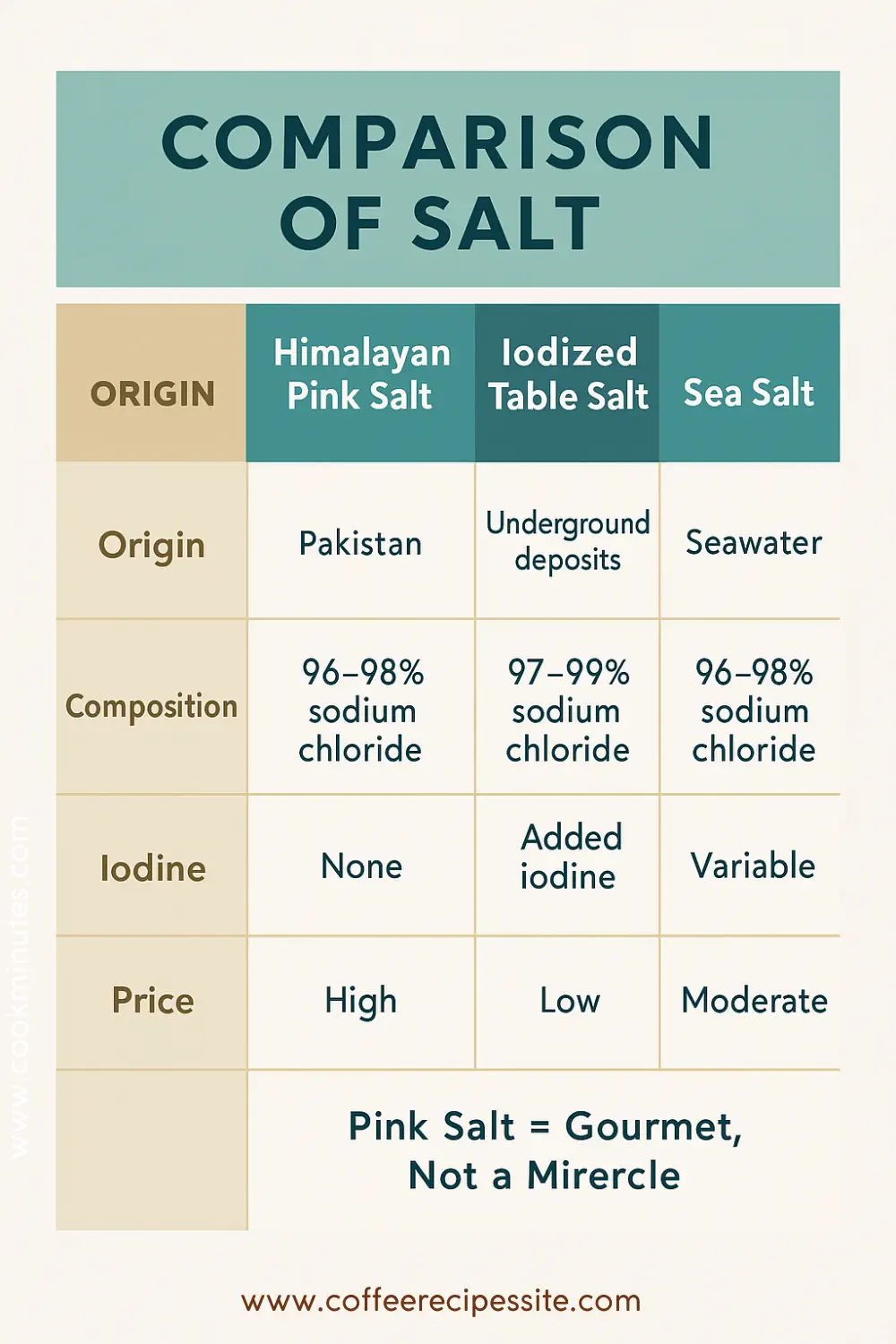
A Gourmet Salt, Not a Miracle Product
Himalayan pink salt has become popular for its soft color and gourmet appeal. But beyond its aesthetics, it is almost identical to regular salt. Its role is culinary, not medicinal.
The main takeaway is balance: enjoy pink salt for taste and presentation, but rely on iodized salt to meet essential nutritional needs. Most importantly, moderation in total salt intake matters more than the type you choose.
For more inspiration on how to use salts and other ingredients creatively, follow us on Pinterest.
What are the benefits of Himalayan pink salt?
Himalayan pink salt is often appreciated for its color and gourmet appeal. It contains trace minerals like iron and magnesium, but in amounts too small to provide real health benefits. From a nutrition standpoint, its main advantage is culinary, it can enhance presentation and flavor without being nutritionally superior to iodized table salt.
Who should not use Himalayan pink salt?
People at risk of iodine deficiency, such as those living in regions where seafood and dairy intake is low, should avoid relying solely on Himalayan pink salt. Unlike iodized table salt, it does not provide iodine, which is essential for thyroid health. Anyone with medical conditions requiring controlled sodium intake should also follow professional dietary advice before using it regularly.
Is it okay to eat Himalayan salt every day?
It can be used daily as long as total salt intake stays within recommended limits (less than 5 grams per day according to the World Health Organization). However, relying only on Himalayan salt may increase the risk of iodine deficiency. A balanced approach is to enjoy pink salt occasionally for flavor and use iodized salt to cover essential nutritional needs.
What is the healthiest salt in the world?
No type of salt is inherently healthier than another. All salts are mostly sodium chloride and should be consumed in moderation. The “healthiest” choice depends on context: iodized salt is recommended by health authorities because it helps prevent iodine deficiency. Specialty salts like pink salt or sea salt may add variety in taste and presentation but do not offer superior health benefits.
Disclaimer: This article is for informational and educational purposes only. It is not intended as medical advice, diagnosis, or treatment. While care has been taken to ensure accuracy, scientific knowledge evolves and individual needs vary. Always consult a qualified healthcare professional before making changes to your diet, especially concerning salt intake and iodine supplementation.
References
- Harvard T.H. Chan School of Public Health – Salt and Sodium
- Wikipedia – Khewra Salt Mine
- UNESCO – Salt Range and Khewra Salt Mine
- Fayet-Moore F. et al. (2020) – An Analysis of the Mineral Composition of Pink Salt Available in Australia, Nutrients
- Foodwatch – Pink salts are NOT healthier for you (heavy metals & safety concerns)
- Kuttykattil A. et al. (2022) – Consuming microplastics? Investigation of commercial salts, PubMed
- NIH Office of Dietary Supplements – Iodine Fact Sheet for Consumers
- Healthline – Is Pink Himalayan Salt Better Than Regular Salt?

